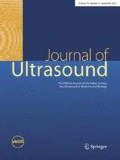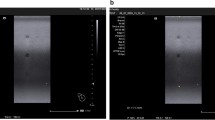Abstract
Diagnostic ultrasound (US) images can be obtained from a quality device, in optimal working conditions, combined with the capable actions of the operator in tweaking the equipment’s characteristics. The quality assurance (QA) is the topic of this review article, and it is addressed in an US practice through proper selection of the equipment when purchasing, and through care and preventive maintenance of the machine for ensuring accurate performance. For optimal US system functioning, QA steps carried out on the basis of a scheduled program are needed in any US practice or department. It is critical to confirm in a semiannual or annual basis that the image quality is maintained according to standards and any subtle change in equipment’s functioning is detected and amended at an early stage. The use of test objects (also called US testing phantoms) is required above the basic level of QA testing. The scope of this review article is to inform the US user about necessary QA knowledge and at the same time, present the state of the art of the most suitable test methods for US QA. We referred to relevant publications, selected after performing a systematic literature search of the MEDLINE, EMBASE and COCHRANE databases, and also to the standards established by authoritative international societies.
Sommario
Immagini ecografiche diagnostiche e di buona qualità possono essere ottenute da un attento controllo, in condizioni di lavoro ottimali, combinato con le capacità dell’operatore di modificare le caratteristiche dell’apparecchiatura ecografica. Il controllo di qualità (QA) è l’argomento di questo articolo di revisione, ed è indirizzato alla pratica ecografica quotidiana che ha origine nella corretta selezione dell’apparecchiatura al momento dell’acquisto, passando per la cura e la manutenzione preventiva della macchina in modo da garantire sempre prestazioni accurate con standard elevati. Per il funzionamento ottimale del sistema eccografico,controlli periodici e programmati sono necessari in qualsiasi studio o dipartimento ospedaliero. È fondamentale infatti, confermare, su base semestrale o annuale, che la qualità dell’immagine sia mantenuta secondo gli standard e che qualsiasi cambiamento sottile nel funzionamento delle apparecchiature sia rilevato e modificato nella fase iniziale possibile. Talvolta può essere richiesto l’uso di oggetti (chiamati fantocci) qualora sia necessario un livello superiore di controllo. Lo scopo di questo articolo di revisione è informare l’utente della necessaria conoscenza del controllo di qualità e, allo stesso tempo, presentare lo stato dell’arte i metodi di prova più adatti per il controllo della qualità delle apparecchiature ecografiche. Abbiamo fatto riferimento a pubblicazioni pertinenti, selezionate dopo aver effettuato una ricerca sistematica della letteratura sui database MEDLINE, EMBASE e COCHRANE e anche sugli standard stabiliti da autorevoli società internazionali.

(Courtesy of Institute of Physics and Engineering in Medicine)








Similar content being viewed by others
References
Institute of Physics and Engineering in Medicine (IPEM) (2009) Quality assurance of ultrasound imaging systems, report no. 102. York
American College of Radiology (ACR) (2011) ACR technical standard for diagnostic medical physics performance monitoring of real time ultrasound equipment Res.3. www.acr.org/Quality-Safety/Standards-Guidelines/Technical-Standards-by-Modality/Medical-Physics
Laurel MD (2008) American institute of ultrasound in medicine (AIUM). Routine quality assurance for diagnostic ultrasound equipment. Report 2008. USA
Martensson M, Olsson M, Segall B et al (2009) High incidence of defective ultrasound transducers in use in routine clinical practice. Eur J Echocardiogr 10:389–394
Kollmann C, deKorte C, Dudley NJ, Gritzmann N, Martin K (2012) Evans DH; EFSUMB technical quality assurance group–US-TQA/B. Guideline for technical quality assurance (TQA) of ultrasound devices (B-Mode)–version 1.0 (July 2012): EFSUMB technical quality assurance group–US-TQA/B. Ultraschall Med 33(6):544–549
Mrazek-Pugh B, Blumenfeld YJ, Lee HC, Chueh J (2015) Obstetric ultrasound quality improvement initiative-utilization of a quality assurance process and standardized checklists. Am J Perinatol 32(6):599–604
Mårtensson M, Olsson M, Brodin LÅ (2010) Ultrasound transducer function: annual testing is not sufficient. Eur J Echocardiogr 11(9):801–805
King DM, Hangiandreou NJ, Tradup DJ et al (2010) Evaluation of a low-cost liquid ultrasound test object for detection of transducer artefacts. Phys Med Biol 55:N557–N570
Hangiandreou NJ, Stekel SF, Tradup DJ et al (2011) Four-year experience with a clinical ultrasound quality control program. Ultrasound Med Biol 37:1350–1357
Dudley NJ, Griffith K, Houldsworth G et al (2001) A review of two alternative ultrasound quality assurance programmes. Eur J Ultrasound 12:233–245
Grice JV, Pickens DR, Price RR (2016) Technical note: a new phantom design for routine testing of doppler ultrasound. Med Phys 43(7):4431
Cantisani V, David E, De Virgilio A, Sidhu PS, Grazhdani H, Greco A, De Vincentiis M, Corsi A, De Cristofaro F, Brunese L, Calliada F, Blandino A, Tombolini M, Ascenti G, Stramare R, Caratozzolo M, D’Ambrosio F (2017) Prospective evaluation of quasistatic ultrasound elastography (USE) compared with baseline US for parotid gland lesions: preliminary results of elasticity contrast index (ECI) evaluation. Med Ultrason 19(1):32–38
Russell S (2014) Ultrasound quality assurance and equipment governance. Ultrasound 22(1):66–69. https://doi.org/10.1177/1742271X13517694
Berg WA, Bandos AI, Mendelson EB, Lehrer D, Jong RA, Pisano ED (2015) Ultrasound as the primary screening test for breast cancer: analysis from ACRIN 6666. J Natl Cancer Inst 108(4):djv367
National Health Service (NHS) (2011) Guidance notes for the acquisition and testing of ultrasound scanners for use in the NHS breast screening programme. NHSBSP Publ. #70. http://www.cancerscreening.nhs.uk/breastscreen/publications/nhsbsp70.html. Accessed 26 June 2012
Dudley NJ, Chapman E (2002) The importance of quality management in fetal measurement. Ultrasound Obstet Gynecol 19(2):190–196
Silosky MS, Marsh RM, Scherzinger AL (2016) Imaging acquisition display performance: an evaluation and discussion of performance metrics and procedures. J Appl Clin Med Phys 17(4):334–341. https://doi.org/10.1120/jacmp.v17i4.6220
Author information
Authors and Affiliations
Corresponding author
Ethics declarations
Conflict of interest
Authors declare that have no conflict of interest.
Informed consent
Informed consent was not necessary for this type of study.
Research involving human and animal rights
This paper does not contain any studies with human participants and/or animals performed by any of the authors.
Rights and permissions
About this article
Cite this article
Grazhdani, H., David, E., Ventura Spagnolo, O. et al. Quality assurance of ultrasound systems: current status and review of literature. J Ultrasound 21, 173–182 (2018). https://doi.org/10.1007/s40477-018-0304-7
Received:
Accepted:
Published:
Issue Date:
DOI: https://doi.org/10.1007/s40477-018-0304-7




